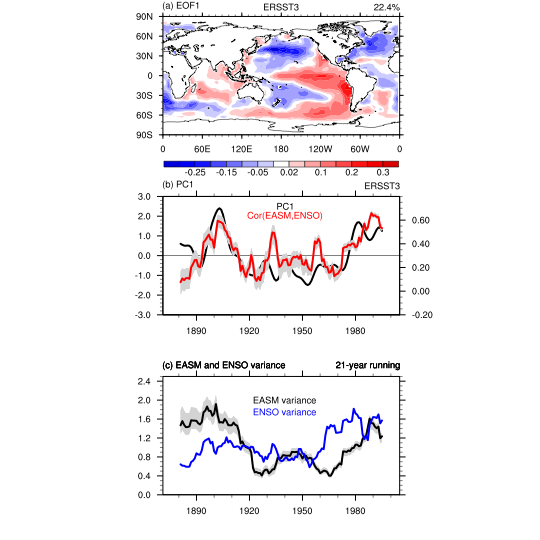The crucial role of internal variability in the East Asian summer monsoon-ENSO relationship during the 20th century
Date:2015-11-11
The El Nino-Southern Oscillation (ENSO), the dominant mode at the inter-annual time scale, exerts crucial influence on the East Asian summer monsoon (EASM) in the following summer. For example, after the extreme 1997/1998 El Nino, a great flood occurred over the eastern China in the summer of 1998. However, the ENSO’s influence on the EASM is not stable, and it changes significantly in different decades.
At the decadal time scale, both climate internal variability [e.g. Interdecadal Pacific Oscillation (IPO) and Atlantic Multi-decadal Oscillation] and external forcing (e.g. greenhouse gases and aerosols) are important for climate variation. Hence, what controls the variation of ENSO-EASM relationship, climate internal variability or external forcing?
"We need to understand this question from a long-term view by combining the observation and climate model.” Dr. SONG said. He and his supervisor Prof. ZHOU Tianjun from Institute of Atmospheric Physics, Chinese Academy of Sciences, found that the climate internal variability plays a crucial role in the EASM-ENSO relationship in the whole 20th century. This conclusion is obtained by comparing the EASM-ENSO relationship before/after removing the external forcing, which is estimated from CMIP5 models. The EASM-ENSO relationship remains almost unchanged after the external forcing is removed. They also pointed out that the EASM-ENSO relationship varies significantly when all the external forcing is fixed at the pre-industrial level, further supporting the conclusion.
The next question is which kind of the internal variability is involved for the EASM-ENSO relationship? The IPO, the dominant mode at the decadal time scale, is found to be responsible for the EASM-ENSO relationship. The mechanism is summarized as following: In the positive IPO phase, the warmer East China Sea weakens the western North Pacific subtropical high, inducing more mean-state precipitation. Thus, the Kelvin wave–induced divergence at the inter-annual time scale suppresses more mean-state precipitation and leads to a stronger EASM.

FIG. 1 The leading mode (EOF1) of low-pass filtered global SST in annual mean after removing the external forcing, showing (a) the spatial pattern and (b) the corresponding PC1. Also shown in (b) is the 21-yr running correlation between the EASM and Ni?o-3.4 index in the previous winter (red line). (c) The 21-yr running variance of the standardized EASM (black line) and Ni?o-3.4 (blue line) index in the previous winter. The gray shading in (b) and (c) indicates the 5th and 95th percentiles of the running correlation and EASM variance, respectively. (Song and Zhou, 2015)
This study emphasizes the role of internal variability in the EASM-ENSO relationship in the 20th century and also points out the IPO’s modulation effect. Because the IPO varies at the decadal time scale, it can be used as a background indicator for the prediction of ENSO’s influence on the EASM.
Reference:
Song Fengfei, Tianjun Zhou, 2015: The crucial role of internal variability in modulating the decadal variation of the East Asian summer monsoon-ENSO relationship during the 20th century, Journal of Climate . 28, 7093-7107
Contact: ZHOU Tianjun, zhoutj@lasg.iap.ac.cn
